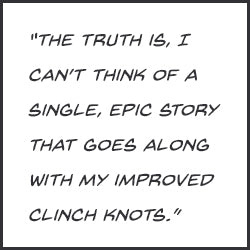A while back, we got a Facebook comment suggesting “politely” that we didn’t know anything about tying knots. The reason? We didn’t mention that you should wet the line when pulling a knot tight.
The reason for that flaw was that we were shooting a video for the Facebook page and, unfortunately, we had to cut time somewhere, and that came when we opted not to wet the line (and we were working indoors anyway, so I didn’t have a pond handy). Although we agree with the commenter’s general advice, the incident brings up a whole new lesson: Everybody seems to have their own way of doing things. When you read our Tying Tips series, don’t feel that you’re signing a contract for life. Mess with the techniques we offer, and those offered by other experts, until you find the method that works perfectly for you. We welcome your comments.
A popular way to start blog posts is with an anecdote, or a short story that’s relevant to the themes presented. For example, if I wanted to impress upon just how great the improved clinch knot was, I might tell you about the massive tarpon I managed to bring in while vacationing in Florida earlier this year.
But that didn’t happen (unfortunately).
 The truth is, I can’t think of a single epic story that goes along with my improved clinch knots. The reason why I keep returning to them is because of the opposite mindset: I also can’t think of a time when this knot pulled loose on me. I may snap a line every once in awhile, but that’s usually the result of sharp teeth on my hooks nicking the line, or me just being too lazy to retie when the line is in bad shape. This is why I would recommend the improved clinch knot to anyone who’s a beginner. When you do it right, it will reward you with less need to learn new knots down the line.
The truth is, I can’t think of a single epic story that goes along with my improved clinch knots. The reason why I keep returning to them is because of the opposite mindset: I also can’t think of a time when this knot pulled loose on me. I may snap a line every once in awhile, but that’s usually the result of sharp teeth on my hooks nicking the line, or me just being too lazy to retie when the line is in bad shape. This is why I would recommend the improved clinch knot to anyone who’s a beginner. When you do it right, it will reward you with less need to learn new knots down the line.
Here’s my spin on tying an improved clinch knot (it’s tough to follow along in text, I admit. Feel free to check your work with a great video from Berkley Fishing at the bottom). If you’re like me and your eyes just aren’t working like they used to, scroll down to the bottom. I’ve prepared a new video showing how you can use a TYEPRO fishing tool to make the improved clinch easier to tie.
How to Tie an Improved Clinch Knot
STEP 1) Thread the eyelet, bringing enough line through for you to work with comfortably. I prefer six inches but there’s no shame in needing more. This is what’s known as the “tag line.”
STEP 2) The line that hasn’t come through the eyelet is the “standing line.” Take the tag line and rotate it around the standing line four to seven times, depending on what weight line you’re using. Just know that the lighter the line, the more you’ll need to wrap it. If you’re using braided line (check out our next post to learn more about basic fishing line types), add an extra three or four wraps. This variety is more likely to pull loose than others.
TIP: Check out the packaging or website for the manufacturer of your line. Often, they’ll publish recommendations specifically for their products.
STEP 3) Take your tag line and run it through the loop between your eyelet and the wraps, and then bring it through the bigger loop you created. Start to pull the knot tight, but beware: pull the standing line to keep your wraps from overlapping...this weakens the knot. Here, Facebook commenter, is where you wet the line, using either fish attractant or water (I prefer the latter). A lubricated wet line can actually be pulled tighter than a dry one.
STEP 4) Trim the tag end, but no more than 1/16th of an inch. You’ll want to leave even more leeway for heavier lines, as tension applied by fish and snags will make this end get shorter.
Need Help With Your Knot-Tying?
If you’re like me, the first step in this process has become tougher than it needs to be. I refer to “threading the eyelet,” a simple process made difficult by aging hands and aging vision. I designed TYEPRO tools as an aid to make the process less strenuous. Check out the video below to see how to tie an improved clinch knot with the help of a TYEPRO.



1 thought on “Tying Tips: How to Tie an Improved Clinch Knot”
kenton morse
THIS MAKES TYING A KNOT ON THE HOOK OR JIG. SO EASY.